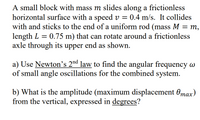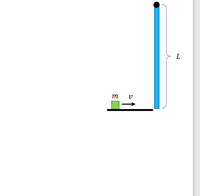Question

Transcribed Image Text:A small block with mass m slides along a frictionless
horizontal surface with a speed v =
with and sticks to the end of a uniform rod (mass M = m,
length L = 0.75 m) that can rotate around a frictionless
axle through its upper end as shown.
:0.4 m/s. It collides
%3D
a) Use Newton's 2nd law to find the angular frequency w
of small angle oscillations for the combined system.
b) What is the amplitude (maximum displacement 0max)
from the vertical, expressed in degrees?

Transcribed Image Text:L
m v
Expert Solution
This question has been solved!
Explore an expertly crafted, step-by-step solution for a thorough understanding of key concepts.
This is a popular solution
Trending nowThis is a popular solution!
Step by stepSolved in 4 steps

Knowledge Booster
Similar questions
- Refer to the question below.arrow_forwardWhile visiting the Albert Michelson exhibit at Clark University, you notice that a chandelier (which looks remarkably like a simple pendulum) swings back and forth in the breeze once every T = 6.6 seconds. Frequency is = 1/6.6 Angular Velocity = 0.952 Length of the chandelier = 10.81 That evening, while hanging out in J.J Thompson's House O' Blues, you notice that (coincidentally) there is a chandelier identical in every way to the one at the Michelson exhibit except this one swings back and forth 0.11 seconds slower, so the period is T + 0.11 Seconds. Determine the acceleration due to gravity in m/s^2 at the clubarrow_forwardA solid brass ball with radius r = 10cm rolls smoothly from the top of the roof that is 6m long and inclined 20°.Using energy conservation law, calculate a) the angular velocity of the ball at the edge, b) the velocity of the centerof mass of the ball at the same moment. The moment of inertia of a solid sphere rotated about its center isI=2/5MR2arrow_forward
- Problem An electric motor provides a constant torque of 12 N.m on a pivoting flywheel which has an inertia around the shaft of 3 kg.m2 and a friction constant of 3 kg.m2 / s. Motor it starts with silence. Zero tolerance is expressed in 2% to face value. 1. Calculate the total work done by the torque from rest until equilibrium is reached angular velocity! 2. Calculate kinetic energy when angular velocity equilibrium is reached! 3. Calculate the average power given by the motor from idle until it is reached equilibrium!arrow_forwardA 1.7 kgkg , 20-cmcm-diameter turntable rotates at 140 rpmrpm on frictionless bearings. Two 450 gg blocks fall from above, hit the turntable simultaneously at opposite ends of a diameter, and stick. What is the turntable's angular velocity, in rpmrpm, just after this event? Express your answer to two significant figures and include the appropriate units.arrow_forwardBar AB has the angular motions shown. Suppose that ωAB = 3.1 rad/s and αAB = 5.6 rad/s2. (a) Determine the velocity of the slider block C at this instant. (b) Determine the acceleration of the slider block C at this instant.arrow_forward
arrow_back_ios
arrow_forward_ios